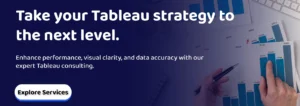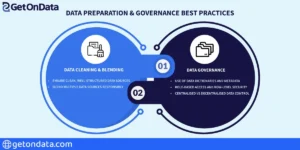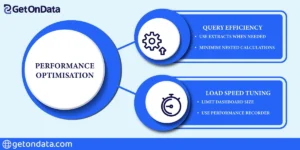Tableau Agent is a reliable AI helper that uses conversational AI to help novice analysts more quickly and effectively collect, analyze, and visualize data. Using statistical analysis and generative AI, Tableau data visualization consulting comprehends the context of your data and helps you with activities like data preparation in Tableau Prep, data documentation in Tableau Catalogue, and data exploration or visualization in Tableau Cloud Web Authoring.
The cooperation between sophisticated AI and human supervision is a crucial component of its operation. One of Tableau Agent’s most important features is that a person is constantly participating in the process, making sure that every suggested response is carefully examined before being approved. In the following blog, we’ll discuss the tableau data visualization consulting best practices your consulting partner should follow.
Understanding Tableau’s Role in Business Intelligence
Businesses in today’s data-driven environment depend on precise and useful information to guide their choices and spur expansion. Implementing Tableau can help with that. With the help of Tableau, a business intelligence tool, businesses can interactively and easily view and understand their data.
In order to obtain more comprehensive information, make data-driven choices, and cultivate a data-driven culture, businesses use Tableau analytics consulting services to convert raw data into interactive and aesthetically pleasing dashboards. Both technical and non-technical people may utilize it because of its intuitive interface, drag-and-drop capabilities, and capacity to connect to several data sources. According to a 2024 Gartner report, organizations that implement data visualization tools like Tableau see a 25% improvement in decision-making speed and a 22% increase in operational efficiency within the first year of adoption.
Businesses want knowledgeable partners who can offer implementation, training, and continuing support to optimize the ROI of Tableau data visualization consulting services ROI. These partners assist businesses in getting the most out of Tableau’s features, which enhances data-driven decision-making and improves business results.
Data Preparation & Governance Best Practices
►Data Cleaning & Blending
Accurate analysis and efficient data governance depend on data preparation, which includes critical components like data blending and cleansing. Searching & recovering errors in datasets is known as data cleaning in Tableau Analytics Consulting Services, whereas combining data from multiple sources is data blending.
In order to guarantee that the remaining data is correct, consistent, and trustworthy, this procedure methodically examines data to identify and eliminate any corrupt, missing, or unnecessary information. Establishing the groundwork for efficient data analysis and reporting, data cleansing by the Tableau consulting company is a crucial phase in the data management process. Without it, businesses run the danger of basing their plans on inaccurate information, which may result in missed opportunities and resource waste.
Data blending is blending information from a few sources to build a broad dataset that can be examined to reveal more in-depth information and aid in decision-making. In terms of marketing, data blending enables marketers to learn more about the success of campaigns across various channels and consumer behavior.
By improving multi-channel attribution, teams are better able to comprehend the whole customer experience and the significance of every touchpoint. This tableau implementation service involves combining information from several platforms, including email marketing tools, social media, web analytics, and CRM systems. By combining several data points into a single picture, this approach enables marketers to do thorough analysis and reporting.
In conclusion, in order to improve data quality and facilitate efficient analysis, data cleaning and data blending are essential procedures in data preparation. While data blending integrates information from several sources to provide a single perspective, data cleaning includes finding and fixing mistakes, contradictions, and missing values in a dataset.
►Data Governance
By ensuring that the appropriate data is accessible to the appropriate individuals at the appropriate moment, Tableau’s data governance promotes confidence and facilitates well-informed decision-making. Data dictionaries and metadata management are essential for ensuring data quality, consistency, and trust in Tableau performance tuning services, according to data governance best practices. While metadata management keeps track of ownership, ancestry, and other important details about data assets, a data dictionary gives definitions for data pieces. Users can locate, comprehend, and apply data for analysis with confidence because of this method.
Data integrity and security are maintained in tableau analytics consulting services by limiting user access to only the data they are permitted to view through the use of role-based access and row-level protection. This is essential for businesses that use Tableau to handle sensitive data or when several user groups want access to different data sets.
Both centralized and decentralized control are options for implementing data governance in Tableau, and each has its own pros and cons. While decentralized control encourages adaptability and user empowerment, centralized control provides consistency and makes administration simpler. A hybrid model for tableau best practices for data sources that capitalizes on the advantages of both is frequently the best course of action.
►Your Consulting Partner Should:
➥Audit your data sources
As a best practice for Tableau data governance, a consulting partner should evaluate your data sources to guarantee data security, compliance, and quality. To find possible hazards and possibilities for improvement, this involves evaluating the source systems, data quality, and access restrictions.
➥Implement scalable governance frameworks
To safely handle data and content and guarantee trust and confidence in data-driven choices, a consulting partner should execute Tableau best practices, scalable governance frameworks in Tableau by defining explicit data standards, procedures, and rules.
➥Maintain data lineage and documentation
As part of data governance, Tableau best practices, a consulting partner should place a high priority on keeping thorough documentation and data lineage. This guarantees the organization’s data assets are managed effectively and transparently.
Also read :- Navigating the Future of Data Analytics for SMEs with Tableau’s AI Tools
Dashboard Design & User Experience
►Design Principles
It takes more than just putting charts on a website to create a dashboard. Your audience should come first. The dashboard is being used by whom? What matters most to them? What enquiries are they attempting to address? Important information should be given priority. Put the most important KPIs, such as headcount trends, turnover rate, or diversity indicators, in the middle of the dashboard, for instance, if it is intended for the HR staff.
Modern UI dashboard design has been popular recently because of design tools like Adobe Illustrator and Figma. The tableau best practices for performance dashboards’ appearance and feel provide the user base with a completely new, rich experience. It helps provide a fresh approach to the dashboard, providing customers with a rich visual experience that is connected to strong interaction. Take a look at the dashboard below, which was created using Tableau and Figma and is not OTB. The dashboard’s perspective also contributes to the desire to return and compile business insights, which should result in the ideal combination of output.
When designing a dashboard through tableau data visualization consulting for a better user experience, focus on clarity, use consistent colors, spacing & fonts. Keep the dashboard design focused and avoid clutter.
►Interactive Elements
Interactive components in Tableau dashboards best practices may greatly increase the engagement and insight of Tableau dashboards. The use of filters, settings, and actions to enable users to examine data, personalize displays, and delve into specifics is emphasized in best practices for dashboard design. Deeper comprehension and useful insights result from this more dynamic and tailored experience.
Dashboards with interactive features are more entertaining and interesting to use, which motivates users to go further into data exploration. Users may go deeper into the data, find hidden patterns, and develop a more sophisticated knowledge of the material by utilising interactive elements. Interactive dashboards may be made to encourage particular behaviours, including tracking success against key performance metrics or pinpointing areas that need work.
►Your Consulting Partner Should:
➥Follow Tableau’s visual best practices
To guarantee efficient and understandable data presentation, a consulting partner should follow Tableau’s visual best practices. For a user-friendly experience, this involves choosing suitable chart kinds, making adjustments for readability, and utilising interactivity. Make sure the dashboard is clear and free of clutter. This requires the use of suitable colour schemes, succinct headings, and unambiguous labelling.
➥Build for different user types (analysts, execs, ops)
Building Tableau dashboards that are suited to various user types, such as experts, executives, and operations teams, should be a top priority for a consulting partner in order to guarantee that everyone can quickly access and comprehend the data pertinent to their positions. This involves creating unique dashboards for every user group with the right degrees of data and visualizations.
➥Prioritize mobile responsiveness and accessibility
Prioritize accessibility and mobile responsiveness while providing consulting for Tableau projects. This involves creating dashboards that are readable by those with disabilities and adjust to various screen sizes so that a larger audience may gain from the information. Create customized views for PCs, tablets, and phones by utilising Tableau’s device-specific dashboard layouts. To explain visualizations, include text in tooltips, titles, and captions rather than just visual components.
Performance Optimization
►Query Efficiency
Reduce the amount of data, optimize computations, and simplify the user interface to improve Tableau dashboard performance. This tableau layout best practices contains restricting filters, minimising the amount of marks, optimising computations, and using data extracts. Reduce the quantity of data handled, optimize data source interactions, and use Tableau’s tools for effective data handling if you want to increase query efficiency in Tableau. This involves reducing data transfers, making sensible use of extracts, refining filters, and efficiently organising your data sources.
When working with Tableau, performance may be greatly enhanced by using extracts rather than live connections, particularly when real-time data is not essential. For data analysis and visualization, extracts are often faster, which enables faster query execution and a more responsive user interface.
►Load Speed Tuning
Optimising data sources, lowering the volume of data imported, and simplifying visualizations are the main ways to increase Tableau load speed. This may be accomplished via pre-aggregating data, optimizing computations and filters, filtering data at the source, and employing Tableau extracts rather than live connections for huge datasets.
By capturing user activities and examining how they affect performance, the Performance Recorder assists in identifying dashboard items that load slowly. Use the Workbook Optimizer to identify areas for enhancement based on best practices after first identifying bottlenecks with the Performance Recorder.
Optimize visual components, decrease interaction, and divide complicated material into many dashboards to reduce the total dashboard size and enhance Tableau dashboard performance. Another benefit of fixed-size dashboards is that they avoid re-rendering for various window sizes.
►Your Consulting Partner Should:
➥Benchmark load times
To guarantee the optimum dashboard performance, a Tableau consulting partner should compare load times as a fundamental best practice. To find bottlenecks and opportunities for improvement, load times for various dashboards and visualizations must be routinely measured and analyzed.
➥Optimize workbook structure
A consulting partner should concentrate on reducing complexity, simplifying the quantity of worksheets and markings, and sparingly use filters in order to maximize workbook structure in Tableau. To improve efficiency and shorten load times, they should also make use of features like data extracts and suitable degrees of information.
➥Guide you on Tableau Server vs Online performance
You should get advice from a consulting partner on how to maximize Tableau Server and Tableau Online performance. Pay attention to user traffic, infrastructure, and extract optimization for the server. Make the most of Online’s cloud-based capabilities while maintaining data sources and visualizations.
Testing & Deployment Practices
►Version Control
To guarantee peak performance and user experience, Tableau testing and deployment best practices combine careful planning, thorough testing, and effective deployment techniques. From basic establishment to later upgrades, these tableau design best practices cover a wide range of topics.
►Testing Workbooks
It is essential to extensively test Tableau workbooks before deployment in order to guarantee correctness, performance, and a satisfying user experience. Testing data connectivity, functionality, user experience, and performance under many circumstances is an important procedure.
►Deployment Strategy
Careful preparation, testing, and a clear strategy are necessary for an effective Tableau Server setup. Among other things, this involves taking disaster recovery, content organization, security, and hardware needs into account. It is frequently advised to implement the change gradually, beginning with a trial group.
►Your Consulting Partner Should:
➥Follow structured deployment processes
A successful implementation of Tableau depends on adhering to organized deployment procedures. Planning, environment setup, program installation and configuration, system management, and system monitoring are all part of this.
➥Provide change logs and rollback options
Version control for spreadsheets and data sources, change logging for server operations, and backup and restore features are essential for efficiently managing changes and enabling rollbacks in Tableau. This method guarantees the ability to monitor changes, go back to earlier iterations, and recover from possible problems.
➥Ensure smooth handovers post-implementation
Create comprehensive documentation, offer in-depth training, and use version control to guarantee seamless Tableau workbook handovers. This will reduce interruptions and optimize the return on your Tableau investment by enabling new users to rapidly comprehend and use current worksheets.
Also read :- Why Is Tableau The Best Data Visualization Tool For Businesses?
Training, Enablement & Documentation
Implementing thorough training, enablement, and documentation procedures is essential to ensuring that Tableau uptake and usage are effective. This involves developing a strong enablement intranet, offering focused training resources, and producing user-friendly documentation. By following these procedures, users will feel more empowered, require less help, and get the most out of Tableau.
►Your Consulting Partner Should:
➥Offer training sessions or video walkthroughs
Seminars and video walkthroughs are essential for promoting best practices in Tableau. These tools increase data analysis and visualizations by assisting users in comprehending and successfully putting best practices into practice.
➥Provide knowledge transfer and user handbooks
Focus on producing clear, succinct, and actionable material that is appropriate for user roles and skill levels in order to deliver user manuals and knowledge transfer in Tableau that works. This tableau design best practice involves selecting Tableau’s instructional materials, adding organizational context, and arranging them into learning programs with defined objectives and due dates.
➥Empower your in-house team for future maintenance
– Focus on offering easily accessible training, encouraging a data-driven culture, and creating best practices for dashboard design and development if you want to utilize Tableau to empower your internal team.
Tableau Server & Governance (If Applicable)
In order to guarantee security, dependability, and effective use, Tableau Server governance and best practices entail controlling users, content, and data inside the Tableau environment. This involves developing precise procedures for content generation and distribution, defining roles and permissions, and putting data quality checks into place. To manage access to projects, workbooks, and data sources, utilize strong authentication techniques (such as Active Directory and Tableau SSO) and precisely specify user roles and permissions.
►Your Consulting Partner Should:
➥Help manage Tableau Server securely
You should follow a few recommended practices to improve the security of your Tableau Server. These include setting up SSL/TLS for safe communication, putting robust authorization and authentication in place, efficiently controlling user access, and patching and upgrading the system on a regular basis.
➥Set up automated alerts and usage dashboards
Focus on determining crucial criteria, selecting the appropriate warning type, and maximizing communication frequency to prevent alert fatigue in order to set up automatic alerts in Tableau efficiently.
➥Monitor and refine over time
Continuous monitoring and improvement of the Tableau integration services dashboards is necessary to guarantee peak performance and user satisfaction. This involves monitoring resource utilization on a regular basis, identifying workbooks that are sluggish, and streamlining computations and data sources.
Ready for Better Insights? We Help You Get Tableau Right
Business leaders and C-level executives understand that large-scale analytics tableau best practices are a strategic necessity. However, converting dispersed reports into an intelligent, scalable analytics environment is a challenge for many organizations. This blog examines the ways in which Tableau analytics by Tableau consulting companies might enable businesses to create that environment.
Now is the moment to take action if you’re prepared to improve the analytics capabilities of your company with the Tableau consulting company. You can start by evaluating your current analytics ecosystem against the above framework, identifying any gaps and quick wins, and involving your leadership in settling on a vision for a bright, scalable analytics future, regardless of whether you’re new to Tableau or seeking to grow an existing deployment.




